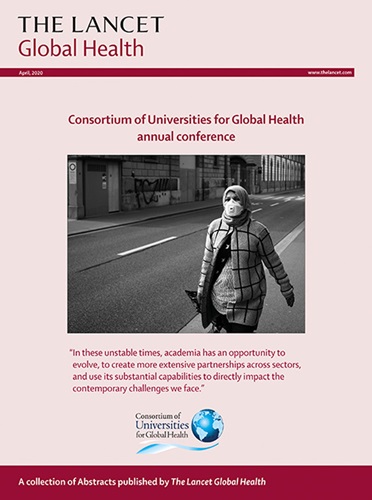Treatment of chronic hepatitis B in Ethiopia: 1-year results from a real-life, multicentre, prospective cohort study.
IF 19.9
1区 医学
Q1 PUBLIC, ENVIRONMENTAL & OCCUPATIONAL HEALTH
引用次数: 0
Abstract
BACKGROUND In the global efforts to combat chronic hepatitis B virus (HBV) infection, the African continent is falling behind. Simplified treatment guidelines are recommended by WHO in low-income and middle-income countries, but it is unclear how this approach works in real life. We aimed to address this knowledge gap using a simplified treatment programme in Ethiopia. METHODS We did a prospective cohort study in four public hospitals in Ethiopia. We enrolled HIV-negative adults (age ≥18 years) with chronic HBV infection and applied simplified treatment criteria on the basis of clinical assessment, aspartate aminotransferase-to-platelet ratio index (APRI), alanine aminotransferase, and point-of-care HBV DNA. The primary endpoint was 1-year treatment outcome (active in care, dead, or lost to follow-up), and secondary endpoints were virological and biochemical treatment response. We used Cox proportional hazards regression models to identify predictors of death and logistic regression models to explore associating factors with decompensated cirrhosis. This study is registered with ClinicalTrials.gov, NCT02344498. FINDINGS Between Dec 8, 2021, and Dec 31, 2023, we enrolled 6010 participants (2953 [49·1%] female and 3057 [50·9%] male; median age 30 years [IQR 25-38]), of whom 1672 (27·8%) were eligible for treatment. 1138 (18·9%) started tenofovir disoproxil fumarate treatment before July 1, 2023, and were included in the 1-year analysis. 532 (46·7%) participants were active in care after 1 year, 58 (5·1%) died, and 508 (44·6%) were lost to follow-up. Of the participants active in care after 1 year, 321 (78·3%) of 410 had virological suppression (HBV DNA ≤10 IU/mL) and 289 (67·5%) of 428 had normal ALT (≤40 U/L). Independent predictors of death were decompensated cirrhosis (adjusted hazard ratio [HR] 8·74 [95% CI 5·01-15·27]) and age (per 1-year increment; adjusted HR 1·03 [1·01-1·05]). Decompensated cirrhosis was associated with male sex (adjusted odds ratio [OR] 1·68 [95% CI 1·17-2·40]), increasing age (per 1-year increment; adjusted OR 1·02 [1·01-1·03]), regular khat use (adjusted OR 1·54 [1·11-2·12]), and HBV DNA concentration greater than 200 000 IU/mL (adjusted OR 1·52 [1·10-2·11]). INTERPRETATION About half of the participants who initiated HBV treatment were still active in care after 1 year, and most of whom had virological and biochemical response to treatment. However, the high proportion lost to follow-up underscores the need for better strategies and tools to improve retention in HBV care. FUNDING The South-Eastern Norway Regional Health Authority and the John C Martin Foundation.埃塞俄比亚慢性乙型肝炎的治疗:一项现实生活、多中心、前瞻性队列研究的1年结果
在全球抗击慢性乙型肝炎病毒(HBV)感染的努力中,非洲大陆落在了后面。世卫组织在低收入和中等收入国家推荐了简化治疗指南,但尚不清楚这种方法在现实生活中如何发挥作用。我们的目标是在埃塞俄比亚使用一个简化的治疗方案来解决这一知识差距。方法在埃塞俄比亚的四家公立医院进行前瞻性队列研究。我们招募了慢性HBV感染的hiv阴性成人(年龄≥18岁),并在临床评估、天冬氨酸转氨酶与血小板比值指数(APRI)、丙氨酸转氨酶和护理点HBV DNA的基础上应用简化的治疗标准。主要终点是1年的治疗结果(积极护理,死亡或随访失败),次要终点是病毒学和生化治疗反应。我们使用Cox比例风险回归模型来确定死亡预测因子,并使用logistic回归模型来探索失代偿性肝硬化的相关因素。本研究已在ClinicalTrials.gov注册,编号NCT02344498。在2021年12月8日至2023年12月31日期间,我们招募了6010名参与者(女性2953人[49.1%],男性3057人[50.9%],中位年龄30岁[IQR 25-38]),其中1672人(27.8%)符合治疗条件。1138例(18.9%)在2023年7月1日前开始接受富马酸替诺福韦二氧吡酯治疗,并纳入1年分析。532名(46.7%)参与者在1年后积极接受治疗,58名(5.1%)死亡,508名(44.6%)失去随访。在1年后积极护理的参与者中,410名患者中有321名(78.3%)出现病毒学抑制(HBV DNA≤10 IU/mL), 428名患者中有289名(67.5%)ALT正常(≤40 U/L)。死亡的独立预测因子为失代偿性肝硬化(校正危险比[HR] 8.74 [95% CI 5.01 - 15.27])和年龄(每1年增加;校正危险比[HR] 1.03[1.01 - 1.05])。失代偿性肝硬化与男性(校正比值比[OR] 1.68 [95% CI 1.17 - 2.40])、年龄增加(每增加1年;校正比值比[OR] 1.02[1.01 - 1.03])、经常使用阿拉伯茶(校正比值比[OR] 1.54[1.11 - 2.12])和HBV DNA浓度大于200000 IU/mL(校正比值比[OR] 1.52[1.10 - 2.11])相关。开始HBV治疗的参与者中约有一半在1年后仍在治疗中活跃,其中大多数人对治疗有病毒学和生化反应。然而,随访损失的高比例强调需要更好的策略和工具来提高HBV护理的保留率。挪威东南部地区卫生局和约翰·C·马丁基金会。
本文章由计算机程序翻译,如有差异,请以英文原文为准。
求助全文
约1分钟内获得全文
求助全文
来源期刊

Lancet Global Health
PUBLIC, ENVIRONMENTAL & OCCUPATIONAL HEALTH-
CiteScore
44.10
自引率
1.20%
发文量
763
审稿时长
10 weeks
期刊介绍:
The Lancet Global Health is an online publication that releases monthly open access (subscription-free) issues.Each issue includes original research, commentary, and correspondence.In addition to this, the publication also provides regular blog posts.
The main focus of The Lancet Global Health is on disadvantaged populations, which can include both entire economic regions and marginalized groups within prosperous nations.The publication prefers to cover topics related to reproductive, maternal, neonatal, child, and adolescent health; infectious diseases (including neglected tropical diseases); non-communicable diseases; mental health; the global health workforce; health systems; surgery; and health policy.
 求助内容:
求助内容: 应助结果提醒方式:
应助结果提醒方式:


